Aquarium Conditioned
Achilles Tang
Acanthurus achilles (Hawaii)
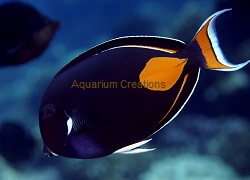
Click to view Achilles Tang in its beautiful reef!
Description:
It is very hard to argue against the fact that the Achilles tang is one of the best looking members of the surgeonfish classification. Their dark (black to brown) bodies and orange tail spot are perfect complements that make the fish a unique and attractive addition to any reef or fish-only aquarium. But the reality is that the fish is difficult to maintain for aquarists of any level except the Expert Aquarist. As more aquarists work to keep difficult species, the requirements these animals have and how to meet them are being worked out. But while there has been a tremendous amount of progress made over the years, there is still a long way to go. Keeping an Achilles tang should only be attempted by aquarists who have the experience, knowledge, and proper aquarium system to keep the animal healthy long-term.
Tank Recommendations:
The Achilles Tang is not for the inexperienced aquarist. However, if you are a very experienced saltwater aquarist, you might think about keeping an Achilles. They are peaceful aquarium inhabitants and will rarely bother their tank-mates. Just about the only exception is when kept with other Surgeonfish, particularly of their own species. Then they will become aggressive towards the other. Being very active during the day they need a large tank with plenty of room to swim about but will also need rocks/ corals to provide some cover and to sleep in at night. Having lots of live rock with algae on them is also great for tangs and helps reduce their aggression by having lots of available food so there isn't much competition for food. As they are primarily herbivores they ignore invertebrates, but lush natural algae growth will be greatly appreciated. The Achilles Tang maximum size is around 9-1/2 inches, slightly smaller in the aquarium, therefore it needs to be kept in a minimum of 180 gallons or larger. They require Turbulent water flow and surface movement (either in the display aquarium or the sump). Heavy surface movement brings higher oxygen levels which will go a long way toward a healthy Achilles Tang.
Food and diet:
The Achilles tang requires a diet very similar to many of the other surgeonfish kept in captivity. These fish are primarily herbivores, so offering them a good crop of freeze-dried algae sheets coupled with an aquarium containing natural-growing algae works well. A. achilles can be a very problematic feeder when introduced to the aquarium. Unlike many surgeonfish that readily accept prepared aquarium foods, the Achilles tang can be picky about what it will accept—if it accepts anything at all. Using frozen fare like mysis shrimp can usually entice these animals to eat. The problem is that such frozen food products do not usually offer the necessary nutrition for this fish—what it needs is macroalgae. I have found that using a rubber band to attach algae sheets to the rockwork in the aquarium works better at enticing Achilles tangs to eat than just sticking an algae clip to the front glass. Spirulina, zucchini, broccoli, and dark green lettuce are all good supplements to the Achilles tang’s diet. I have also had success at preventing parasitic outbreaks by feeding an anti-parasitic food, but I prefer pellet-based foods that do not contain any antibiotic or anti-parasitic chemicals but are simply high in protein and enriched with garlic. Freeze-dried algae infused with garlic can now be purchased, and this will also help prevent parasite-related issues.
Level of Care:
Difficult! Expert Only, Arrive Alive Guaranteed!
Please note: Aquarium Creations guarantees all saltwater fish we offer will arrive alive in good condition. Because of this species increased level of care it is recommended for "Expert Only." That means we are recommending only for an aquarium institution or scientific institution. “Expert Only” marine life is exempt from any longterm guarantee beyond a healthy arrival.
Acclimaton Time:
3+ hours
Reef Compatibility:
Excellent
Approximate Purchase Size:
Small: 1-1/2" to 2" Small/Medium: 2" to 3" Medium: 3" to 4" Medium/Large: 4" to 5" Large: 5" to 6" XLarge: 6" to 7" Show Size 7" to 9"
*Show Size is Special Order, requires 3 to 6 week delivery time.
|
Small $279.00
Small/Medium $299.00
Medium $349.00
Medium/Large $399.00
Large $489.00
XLarge $599.00
*Show $699.00
*Show Size is Special Order, 4 to 6 week delivery time.
|
|
Aquarium Conditioned
White Cheek Tang
Acanthurus nigricans (Indo Pacific)
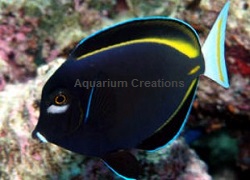
Click to view Beautiful White Cheek in Tom's Reef
Description:
The White Cheek Tang, is also known as the Gold-rimmed Surgeonfish or Whitecheek Surgeonfish. The Whitecheek Tang is shy when introduced to the aquarium and will require suitable hiding places to refuge in if threatened. The Whitecheek Tang can be finicky when it comes to adjusting to eating prepared foods, so a tank with a flourishing algae crop or live rock will ensure it gets enough to eat during the acclimation process. Like most tangs, this species can be aggressive toward surgeonfish tankmates once it acclimates, especially members of its own kind (keep only one per tank).
Tank Recommendations:
125 gallon or larger aquarium with a number of hiding places and plenty of room to swim. We recommend only 1 tang of similar appearance called a look alike surgeon tang in the tank, unless you have a very large tank, since like most tangs, this species can be aggressive toward other look alike surgeonfish.
Food and diet:
The White Cheek Tang requires a diet very similar to many of the other surgeonfish kept in captivity. These fish are primarily herbivores, so offering them a good crop of freeze-dried algae sheets coupled with an aquarium containing natural-growing algae works well. The White Cheek can be a very problematic feeder when introduced to the aquarium. Unlike many surgeonfish that readily accept prepared aquarium foods, the White Cheek tang can be picky at the beginning. Using frozen fare like mysis shrimp can usually entice these animals to eat. The problem is that such frozen food products do not usually offer the necessary nutrition for this fish—what it needs is macroalgae. I have found that using a rubber band to attach algae sheets to the rockwork in the aquarium works better at enticing them to eat than just sticking an algae clip to the front glass. Spirulina, zucchini, broccoli, and dark green lettuce are all good supplements to the diet. For the health of your fish it is always desirable to soak all fish food including algae with vitamins to help keep your fish healthier and less susceptible to disease. Another helpful tip is to soak your fishes food in garlic as well. Especially when adding new fish and whenever your notice ich or other disease in the aquarium. Garlic helps repel external parasites, such as ich, and boosts immunity in all your fish.
Level of Care:
Moderate
Acclimaton Time:
2+ hours
Reef Compatibility:
Excellent
Approximate Purchase Size:
Small 2 to 2-1/2" Small/Medium 2 1/2" to 3" Medium 3" to 4" Large 4" to 5" XLarge 5" to 6"
|
Small $99.99
Small/Medium $129.99
Medium $159.99
Large $199.99
XLarge $299.99
|
|
Aquarium Conditioned
Powder Blue Tang
Acanthurus leucosternon
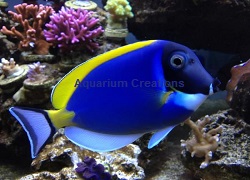 Click to view video of Powder Blue Tang
Click to view video of Powder Blue Tang
Description:
The powder blue tang (often called by its scientific species name leucosternon) is one of the most beautiful and coveted fish for marine aquariums. A mature powder blue tang has many different shades of blue, from dark navy to light powder blue, with bright yellow on the dorsal fin and dramatic black markings on the face.Once established, these fish do very well in an established tank with lots of live rock and swimming room. Keep only one per tank. These fish are very fragile and will not tolerate being abused by other fish.
Tank Recommendations:
Will do best in a reef aquarium with plenty of live rock and hiding places. Provide Powder Blues with plenty of open swimming room. In the wild they swim all over the reef grazing on algae. The Powder Blue Tang will grow to approximately 8 inches in the aquarium therefore it requires an aquarium of at least 125 gallons. In larger aquariums of 300 gallons or more, you can keep them in a small school provided they are added at the same time. Like other tangs, Powder Blue Tangs demonstrate territorial aggression towards their own species, or tangs in general. When introducing a variety or a group of surgeon tangs to an aquarium, it is best to add them in groups to help avoid territorial disputes. Powder Blue Tangs tend to be extra aggressive towards conspecifics with the same body shape such as the White Cheek Tangs and Powder Brown Tangs. Again, this is where adding them together really makes a big difference.
Food and diet:
The White Cheek Tang requires a diet very similar to many of the other surgeonfish kept in captivity. These fish are primarily herbivores, so offering them a good crop of freeze-dried algae sheets coupled with an aquarium containing natural-growing algae works well. The White Cheek can be a very problematic feeder when introduced to the aquarium. Unlike many surgeonfish that readily accept prepared aquarium foods, the White Cheek tang can be picky at the beginning. Using frozen fare like mysis shrimp can usually entice these animals to eat. The problem is that such frozen food products do not usually offer the necessary nutrition for this fish—what it needs is macroalgae. I have found that using a rubber band to attach algae sheets to the rockwork in the aquarium works better at enticing them to eat than just sticking an algae clip to the front glass. Spirulina, zucchini, broccoli, and dark green lettuce are all good supplements to the diet. For the health of your fish it is always desirable to soak all fish food including algae with vitamins to help keep your fish healthier and less susceptible to disease. Another helpful tip is to soak your fishes food in garlic as well. Especially when adding new fish and whenever your notice ich or other disease in the aquarium. Garlic helps repel external parasites, such as ich, and boosts immunity in all your fish.
Level of Care:
Moderate
Acclimaton Time:
2+ hours
Reef Compatibility:
Excellent
Approximate Purchase Size:
Small 2" to 2-1/2" Small/Medium: 2-1/2" to 3-1/2" Medium 3-1/2" to 4-1/2" Medium/Large 4-1/2" to 5-1/2" Large 5-1/2 to 6-1/2" XLarge 6-1/2" to 7-1/2"
|
Small $129.99
Small/Medium $139.99
Medium $149.99
Medium/Large $179.99
Large $199.99
XLarge $249.99
|
|
Aquarium Conditioned
Pacific Sailfin Tang
Zebrasoma veliferum (Indo Pacific)
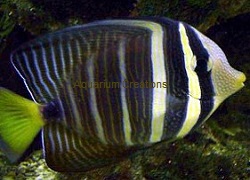
Click to view YouTube Video of Pacific Sailfin Tang
Description:
Sailfin Tang's originate from the warm waters of the Indo-Pacific ocean and Coral Sea where they are found living near coral reefs and rocky outcrops. Sailfin Tang's are part of the popular Zebrasoma family of Surgeon fish that over the years have been very popular within the aquarium hobby. Sailfin Tangs can grow to upwards of 15 inches in the wild, slightly smaller in an aquarium, therefore they require a large aquarium that provides them plenty of swimming room along with large caves or rocky overhangs to retreat to when they feel threatened. It is best to keep this species in a 125 gallon or larger 6 foot plus long aquarium in order to provide them plenty of room to move about. In larger aquariums of 300 gallons or more, you can keep them in a small school provided they are added at the same time. Sailfin Tangs tend to be extra aggressive towards conspecifics with a similar body shape such as the Desjardini Sailfin Tang. Again, this is where adding them together helps. An established Sailfin Tang is sure to give a newly introduced Desjardini Sailfin Tang an aggressive welcoming. Sailfin Tangs are useful in keeping your aquarium looking their best. Sailfin Tangs will eat a wide range of undesirable algae. Reef safe they will not bother corals, clams, or invertebrates. The Pacific Sailfin Tang is relatively peaceful and will get along with a wide variety of tank mates in either the reef environment or a large community aquarium.
Tank Recommendations:
They do well with a large variety of fish species ranging from small Gobies and Clownfish all the way to larger more aggressive species like full size Angelfish or Triggerfish. Sailfin Tangs can also be safely kept with most corals and invertebrates without problems. They will most often exhibit a lot of aggression towards others of the Zebrasoma family, thus should be kept as the only Zebrasoma Tang or in a medium to large group of Zebrasoma Tangs ( 4 or more). They should be provided with plenty of live rock to provide territory, provide supplemental feeding opportunities and provide shelter for sleeping and retreating to safety. As Sailfin Tangs reach a relatively large size of 15 inches, they should be kept in aquariums with strong biological and chemical filtration to handle the relatively large bio-load and provide excellent water conditions.
Food and diet:
Sailfin Tang's are herbivores and mainly eat marine algae and vegetable matter within their natural habitat, but they are known to accept most prepared, meaty food items. However, their diet should mainly consist of a variety of high quality and vitamin enriched marine algae preparations and fresh vegetable matter such as dried sheets of seaweed (also nori), romaine lettuce, broccoli, zucchini, spinach, and quality, Spirulina-based flake foods for herbivores. Although they may also graze on any filamentous algae within the aquarium, they should be fed at least twice a day and fresh vegetables should be offered 3 to 5 times per week. For the health of your fish it is always desirable to soak all fish food including algae with vitamins to help keep your fish healthier and less susceptible to disease. Another helpful tip is to soak your fishes food in garlic as well. Especially when adding new fish and whenever your notice ich or other disease in the aquarium. Garlic helps repel external parasites, such as ich, and boosts immunity in all your fish.
Level of Care:
Moderate
Acclimaton Time:
2+ hours
Reef Compatibility:
Excellent for Reef or Fowlr
Approximate Purchase Size:
Small: 1-1/4" to 2" Small/Medium 2" to 3" Medium: 3" to 4" Medium/Large 4" to 5" Large: 5" to 6"
|
Small $89.99
Small/Medium $99.99
Medium $109.99
Medium/Large $129.99
Large $159.99
|
|
Aquarium Conditioned
Bristle Tooth Tomini Tang
Ctenochaetus tominiensis
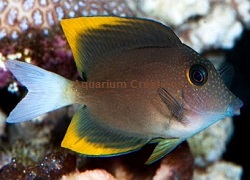
Description:
One of the easiest saltwater fish to keep after acclimated, the Tomini Tang is a great fish for beginners with a sufficient sized aquarium. The Tomini Tang is in the genus Ctenochaetus (pronounced ten-oh-key-tus) and is one of the more commonly kept tangs due to it's staying small as an adult. Tomini Tangs reach up to about 6 inches in size and are fairly hardy too. They are also known to be a very effective grazer in the reef tank, keeping algae under control. They are considered excellent scavengers that are reef tank friendly. The Tomini Tang will constantly pick at the live rock and glass looking for algae and other tid bits. Tomini Tangs will not bother not a single coral, clam, or invertebrate. When keeping more than one species of Tang, it is best to add them at the same time to a larger aquarium. When adding multiple Tangs to the same aquarium, it is best to have the Tomini in place prior to adding Tangs of a different genus.
Tank Recommendations:
Bristletooth Tomini Tangs reach a maximum size of 6 inches and can be kept in a tank that is at least 70 gallons. Bristletooth Tomini Tangs tend to enjoy swimming room, so having a longer tank is more beneficial. Bristletooth Tomini Tangs are peaceful to most other fish, coral and inverts and are great additions to reef tanks. Bristletooth Tomini Tangs will be aggressive to other tangs though, especially those in the Ctenochaetus family. To help reduce the chance of tang aggression, try to introduce all your tangs at the same time and also make sure they have a constant supply of algae to pick at throughout the day.
Food and diet:
Tomini Tang's are herbivores and mainly eat marine algae and vegetable matter within their natural habitat, but they are known to accept most prepared, meaty food items. However, their diet should mainly consist of a variety of high quality and vitamin enriched marine algae preparations and fresh vegetable matter such as dried sheets of seaweed (also nori), romaine lettuce, broccoli, zucchini, spinach, and quality, Spirulina-based flake foods for herbivores. Although they may also graze on any filamentous algae within the aquarium, they should be fed at least twice a day and fresh vegetables should be offered 3 to 5 times per week. For the health of your fish it is always desirable to soak all fish food including algae with vitamins to help keep your fish healthier and less susceptible to disease. Another helpful tip is to soak your fishes food in garlic as well. Especially when adding new fish and whenever your notice ich or other disease in the aquarium. Garlic helps repel external parasites, such as ich, and boosts immunity in all your fish.
Level of Care:
Moderate
Acclimaton Time:
2+ hours
Reef Compatibility:
Great reef or Fowlr aquarium fish.
Approximate Purchase Size:
Small: 1-1/4" to 2" Small/Medium: 2" to 3" Medium: 3" to 4" Medium/Large: 4" to 5" Large: 5" to 6"
|
Small $59.99
Small/Medium $69.99
Medium $99.99
Medium/Large $129.99
Large $179.99
|
|
Aquarium Conditioned
Gem Tang
Zebrasoma gemmatum
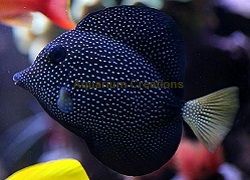
Click for Video of Jake Adam's Incredible Gem Tang,Zebrasoma gemmatum
Description:
Gem tangs demand such a high price for a couple of reasons. First, they are rather rare, with limited Western Indian Ocean distribution, they do not have a wide natural range of habitat. There are also very strict fishing and exporting policies with these beauties. Gem tangs make a fantastic show piece, we've had one in our display tank for over two years now, and he's definitely the favorite! Without question, the Gem Tang is one of the most beautiful species of tang out there - nay, the Gem Tang is one of the most beautiful fish in the entire marine aquarium trade. The Gem Tang is famous for its spectacularly brilliant white spots across its iridescently shimmering black body. Its yellow anal fin further adds to the Gem Tang's starkly contrasting hues. The Gem Tang is considered easy to moderate to keep just like many of the other commonly available Zebrasoma tangs. It adapts well to being in an aquarium. Acclimate them to your tank (or even better, to your quarantine tank) over an period of two hours and keep a skunk cleaner shrimp or red fire shrimp with them to protect your investment.
Tank Recommendations:
With a maximum size of around 9 inches, we recommend the Gem Tang be placed in an aquarium of at least 180 gallons but preferably much larger since they love to swim. Try not to keep them with other tangs because they may fight. That warning is doubled if you plan on keeping them with other Zebrasoma species. Some hobbyists have been fortunate in keeping multiple tangs with a Gem Tang in the same tank. If you do plan on keeping multiples introduce them at the same time and be sure there are plenty of hiding places. If the fighting gets to be too much be prepared to separate them. Being very active during the day they need a tank with plenty of room to swim about but will also need rock to provide some cover and to sleep in at night. Having lots of live rock with algae on is also great for all tangs and helps reduce their aggression by having lots of available food so there isn't much competition for food.
Food and diet:
Gem Tangs are a herbivorous species whose diet should consist primarily of marine algae, seaweed and plant material. They will also feed on meaty foods fed to other fish housed in the aquarium, but the vast majority of their diet should come from plant matter. Gem Tangs are also natural grazers that prefer to feed in smaller amounts throughout the day. The best approach for this species is to provide them seaweed, romaine lettuce, green leaf lettuce or similar items that they can graze on throughout the day. They will also graze on naturally occurring algae growth within the aquarium and will feed on commercial foods designed for both herbivores and omnivores. For the health of your fish it is always desirable to soak all fish food including algae with vitamins to help keep your fish healthier and less susceptible to disease. Another helpful tip is to soak your fishes food in garlic as well. Especially when adding new fish and whenever your notice ich or other disease in the aquarium. Garlic helps repel external parasites, such as ich, and boosts immunity in all your fish.
Level of Care:
Moderate
Acclimaton Time:
2+ hours
Reef Compatibility:
Great addition to any fish-only or reef aquarium system.
Approximate Purchase Size:
2-1/4" to 5"
|
|



 Click to view video of Powder Blue Tang
Click to view video of Powder Blue Tang


